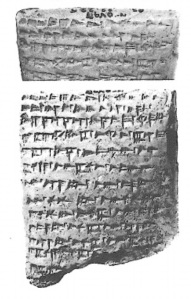I just mentioned Jabba the Hutt in the academic book I’m writing. At first it was a bit of a joke, something that would never make it through the first edit, but actually, the more I think about it, the more I think it’s helpful. I’m going to drop one of those terrible academic clichés now, so forgive me, but when it comes to the Late Bronze Age Mediterranean, Jabba might actually be Good To Think With. Let me explain.
Monsters
Mermaids and Merfolk of the Ancient World
Things have been a little quiet round here recently. Sorry about that – term kind of got in the way. But hopefully now things aren’t quite so busy I’ll be able to get a few things written, starting now.
Let’s talk about mermaids, shall we? Well, not just mermaids but mermen and fish-people of all stripes. I’ve been meaning to write something on this for a while, but a discussion on Twitter this morning about Dagan prompted me to actually get started. Dagan has often been seen as a fish-deity because in Hebrew dag means fish. These Mesopotamian images of mermen and priests dressed as fish are often linked with Dagan.


Where do Monsters Come From? Tracing the Leviathan from Ugarit to Final Fantasy
Rounding out a busy week for the blog (who would have thought that Aegean stuff in Doctor Who would have been so popular?), I have another article up on Eurogamer. This one’s a bit of a sequel to my one looking at the afterlife of Ba’al and traces the sea monster Leviathan from Ugaritic poem to triple-A video-game.

http://www.eurogamer.net/articles/2017-09-30-where-do-monsters-come-from
Under-Appreciated Monsters of the Ancient World #3 – Rabiṣu (The Lurker)

Film poster for ‘Resurrection: Rise of the Rabisu’, which I can’t find much information about and definitely doesn’t look rubbish.
For this little-known monster we head out to Bronze Age Mesopotamia. The Rabiṣu appears in a wide assortment of cuneiform texts, but it’s not exactly clear what it is (this amorphousness is pretty characteristic of Mesopotamian demons). Its name seems to come from the verb rabāṣu – to lie down or lurk, and many texts describe it lying in wait to strike unfortunate men who venture across its path, whether it’s hiding in a dark and dank well or has found its way into your own home. Continue reading
The Afterlife of Baʿal
(or, What This Ugaritian Storm-God Looks Like Now Will Astound You!)

Ba’al on a stele from Ugarit, now in the Louvre

Reconstruction of the Temple of Ba’al on the acropolis of Ugarit. From Callot 2011
- Ever since excavations began at the Syrian city of Ugarit in 1929, the importance of the god Baʿal has been clear. Among the first Ugaritic texts discovered at the site were mythological tablets recounting the legends of this god; Baʿal’s temple was excavated in prime position on the city’s acropolis, close to that of his father Dagan. While the supreme god El occupied the pinnacle of the Ugaritian pantheon, as more and more ritual and religious documents have been recovered from Ugarit, it’s become unquestionable that the city’s people felt a particular fondness and affinity for Baʿal, the archetypal king who had his palace on Mount Saphon overlooking the city.
But Baʿal was not solely an Ugaritian god and knowledge of him was far from lost with the destruction of the city around 1176 BC. Through the distorting filters of hostile Judaeo-Christian writings and the medieval and later traditions of demonology and the occult which reinterpreted them, Baʿal has enjoyed quite an afterlife which has taken him from Canaanite king and storm-god to lurid demon in the court of Satan. In this incarnation he’s spread through popular culture. It’s a massive amount of cultural baggage to have built up even before those first Ugaritic texts were discovered. Continue reading
Under-Appreciated Monsters of the Ancient World #1 – The Sucker

KTU 1.96. From Del Olmo Lete 2010
Everyone knows the Minotaur or the Cyclops, or the various strange creatures of ancient Egypt. In this occasional series I’m going to shine the spotlight on some of the other mythological nasties of antiquity, who are just as cool in their own ways but don’t get nearly enough love.
Today, The Sucker, or ‘Old Big-Eye’.
What are the most Lovecraftian stories in Classic Doctor Who?
I’m going to level with you straight up – this post isn’t going to have a lot of archaeological or academic content (except inasmuch as Lovecraft’s stories themselves are intrinsically archaeological and scholarly in character), so if that’s what you come here for you might want to sit it out and wait for the next one.
 The original run of Doctor Who last more than quarter of a century from 1963 to 1989 and in that time the good Doctor fought everything from the well-known Daleks and Cybermen to the more eccentric – robots made of sweets, gigantic prawn-viruses, rubber-clad men with aerials on their heads, and so on. More than once he’s come up against ancient, unknowable evils ‘Eeeevil, evilsincethedawnoftime!’ as Sylvester McCoy’s seventh Doctor once put it (unfortunately the clip doesn’t seem to be up online anywhere), and especially in the 70s, he’s also seen his fair share of sinister cultists. These are, of course, staples of the works of H. P. Lovecraft, and you’d expect a fair bit of overlap between the kinds of people who read his stories and those who watch and write for Doctor Who.
The original run of Doctor Who last more than quarter of a century from 1963 to 1989 and in that time the good Doctor fought everything from the well-known Daleks and Cybermen to the more eccentric – robots made of sweets, gigantic prawn-viruses, rubber-clad men with aerials on their heads, and so on. More than once he’s come up against ancient, unknowable evils ‘Eeeevil, evilsincethedawnoftime!’ as Sylvester McCoy’s seventh Doctor once put it (unfortunately the clip doesn’t seem to be up online anywhere), and especially in the 70s, he’s also seen his fair share of sinister cultists. These are, of course, staples of the works of H. P. Lovecraft, and you’d expect a fair bit of overlap between the kinds of people who read his stories and those who watch and write for Doctor Who.
Sure enough, once the series was cancelled and the Doctor’s ongoing adventures moved to a series of monthly original novels for the 1990s, some of the fans writing these books tried to forge explicit connections between the cults and formless evils of the old days and the handily out-of-copyright Lovecraftian Cthulhu mythos. There had been a universe before this one, a couple of stories said, and it had its own physical laws and its own equivalent of the Time Lords, the Doctor’s powerful race of time-travellers. When that universe ended, a few of them found ways to survive and emerge into our own, where they acquired previously undreamt-of powers. These became the Great Old Ones, and a number of the Doctor’s old foes were among their numbers. It’s a bit of a silly retcon, of course, an unnecessary link between two bodies of work almost diametrically opposed in their values, attitudes and approaches. But on the other hand, it is kind of fun, and part of Doctor Who’s raison d’etre is mashing itself up with things that don’t quite fit.
So with this in mind, let’s go for a whistle-stop tour through time and see just how Lovecraftian original-flavour Doctor Who could be.
Mummies as Monsters: Reviewing The Book of the Dead
 It’ll be obvious from even the briefest glance over my past posts here that I’ve got a strong interest in both archaeology and monsters. Slap-bang in the middle of that Venn-diagram lies (or staggers stiffly around) the Mummy. More than any other creature, perhaps, the monstrous mummy of literature and film embodies (no pun intended) that fundamental archaeological tension between artefact and person. Most potent when it concerns human remains, the transition from living, breathing person (or the daily accoutrements of a person’s life and world) to an artefact, an object of scientific study, isn’t a comfortable one. Continue reading
It’ll be obvious from even the briefest glance over my past posts here that I’ve got a strong interest in both archaeology and monsters. Slap-bang in the middle of that Venn-diagram lies (or staggers stiffly around) the Mummy. More than any other creature, perhaps, the monstrous mummy of literature and film embodies (no pun intended) that fundamental archaeological tension between artefact and person. Most potent when it concerns human remains, the transition from living, breathing person (or the daily accoutrements of a person’s life and world) to an artefact, an object of scientific study, isn’t a comfortable one. Continue reading
Amphitrite’s Brood: Sea-Monsters in the Classical World
[δείδω μή]
…τί μοι καὶ κῆτος ἐπισσεύῃ μέγα δαίμων
ἐξ ἁλός, οἷά τε πολλὰ τρέφει κλυτὸς Ἀμφιτρίτη:
[I’m afraid] that some god’s going to send a great sea-monster against me; glorious Amphitrite breeds them in numbers.
Odyssey 5.418-21
 Culturally as well as geographically, the sea was central to the Classical world. These days we’re encouraged to think of the Mediterranean as something that united rather than divided the region, teeming with shipping and movement. All of this is true, but sea-faring was also deeply perilous,[1] especially in the autumn and winter. Shipwrecks and deaths at sea were common. It’s no surprise, then, that ancient Mediterranean waters were believed to be home to all manner of monstrous and deadly creatures.
Culturally as well as geographically, the sea was central to the Classical world. These days we’re encouraged to think of the Mediterranean as something that united rather than divided the region, teeming with shipping and movement. All of this is true, but sea-faring was also deeply perilous,[1] especially in the autumn and winter. Shipwrecks and deaths at sea were common. It’s no surprise, then, that ancient Mediterranean waters were believed to be home to all manner of monstrous and deadly creatures.
